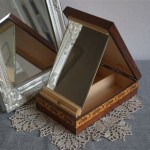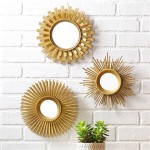Enhancing Living Spaces: The Strategic Use of Wall Mirrors in the Living Room
Wall mirrors serve as more than just reflective surfaces within a living room; they are potent design elements capable of dramatically influencing the perception of space, light, and overall aesthetic. The strategic incorporation of mirrors can transform a mundane living room into a visually appealing and functionally enhanced area. This article will delve into the various ways wall mirrors can be utilized in a living room setting to achieve specific design goals.
Creating the Illusion of Space
One of the primary benefits of incorporating wall mirrors into a living room design is their ability to create the illusion of a larger space. This is particularly valuable in smaller living rooms where maximizing perceived square footage is paramount. The reflective nature of a mirror allows it to visually double the room's dimensions, making it feel more open and airy.
The size and placement of the mirror significantly impact the effectiveness of this technique. A large mirror extending across a significant portion of a wall will generate a more pronounced effect compared to a smaller, decorative mirror. Strategically positioning the mirror to reflect a window or source of natural light further enhances the sense of spaciousness, as it effectively extends the view beyond the room's physical boundaries.
Consider the perspective the mirror will offer. If the mirror reflects a cluttered area, it will simply amplify the visual clutter. Instead, the reflection should focus on a well-lit, aesthetically pleasing aspect of the room, such as a curated gallery wall, a verdant plant arrangement, or a focal point piece of furniture. This will create a more cohesive and visually appealing impression.
Types of mirrors particularly effective for expanding space include full-length mirrors, large rectangular mirrors positioned horizontally, and mirrored panels that cover an entire wall section. The choice depends on the overall design style of the living room and the desired level of impact.
Amplifying Natural and Artificial Light
Beyond their space-enhancing properties, wall mirrors play a crucial role in maximizing both natural and artificial light within a living room. By reflecting incoming light, mirrors can brighten dark corners, illuminate shadowed areas, and create a more vibrant and inviting atmosphere. This is particularly beneficial in rooms with limited natural light sources.
The placement of a mirror in relation to a window is critical for optimizing light reflection. Positioning a mirror opposite or adjacent to a window allows it to capture and redistribute the natural light throughout the room. This can significantly reduce the need for artificial lighting during the day, contributing to energy savings and a more natural and comfortable ambiance.
Similarly, mirrors can be used to amplify the effect of artificial light sources. Placing a mirror near a lamp or chandelier will reflect and disperse the light, effectively increasing the illumination of the room. This is particularly useful in areas where task lighting is required, such as a reading nook or a home office setup within the living room.
Consider the finish of the mirror frame when selecting a mirror for light amplification. A light-colored or metallic frame will reflect more light than a dark-colored frame, further enhancing the mirror's ability to brighten the room. Beveled edges on the mirror can also contribute to light diffusion, creating a softer and more diffused glow.
The strategic combination of both natural and artificial light can dramatically transform the atmosphere of a living room. Mirrors act as powerful tools for harnessing and manipulating light to create a brighter, more inviting, and visually appealing space.
Serving as a Decorative Element and Focal Point
Beyond their functional benefits, wall mirrors serve as significant decorative elements that can enhance the aesthetic appeal of a living room. They come in a wide array of styles, shapes, sizes, and finishes, allowing for seamless integration into various design schemes. A well-chosen mirror can act as a focal point, drawing the eye and adding visual interest to the room.
The style of the mirror should complement the overall design aesthetic of the living room. In a traditional setting, a mirror with an ornate frame and classic detailing would be appropriate. Conversely, a minimalist living room might benefit from a sleek, frameless mirror or one with a simple, geometric frame.
The shape of the mirror can also influence the overall look and feel of the room. Round mirrors soften the angularity of a space and create a sense of flow. Rectangular mirrors, especially when positioned horizontally, can visually elongate a room. Unconventional shapes, such as asymmetrical or organic forms, can add a touch of modern flair and artistic expression.
Consider the scale of the mirror in relation to the surrounding furniture and décor. A large mirror positioned above a sofa or fireplace can create a dramatic focal point. Smaller mirrors can be grouped together to create a gallery wall effect, adding visual texture and interest.
The frame of the mirror offers an opportunity to introduce color, texture, and pattern into the living room. A metallic frame can add a touch of glamour, while a wooden frame can create a more rustic and organic feel. Upholstered frames offer a unique textural element and can be customized to match the room's color palette.
Ultimately, the choice of mirror should reflect personal style and contribute to the overall aesthetic harmony of the living room. A thoughtfully selected mirror can elevate the space from functional to visually captivating, serving as both a practical and decorative element.
Addressing Specific Design Challenges
Wall mirrors can also be strategically deployed to address specific design challenges within a living room. These challenges may include awkward architectural features, unbalanced layouts, or a lack of visual interest. By carefully considering the placement and style of mirrors, these issues can be effectively mitigated.
For example, a narrow or long living room can benefit from a large mirror placed on one of the longer walls. This will visually widen the space and create a more balanced proportion. Alternatively, mirrors can be used to break up the monotony of a plain wall, adding visual interest and depth.
Mirrors can also be used to conceal or downplay undesirable architectural features. A mirror strategically placed to reflect a more appealing area of the room can distract the eye from an awkward corner or an unsightly structural element. Similarly, mirrors can be used to balance an asymmetrical layout, creating a sense of visual equilibrium.
In rooms with low ceilings, vertical mirrors can visually elongate the walls and create the illusion of height. Positioning a tall, narrow mirror near a door or window can draw the eye upwards, making the ceiling feel higher.
Mirrors can also be used to enhance the impact of existing artwork or décor. Positioning a mirror opposite a painting or sculpture will reflect and amplify its visual presence, creating a more dramatic and impactful display.
By considering the specific challenges presented by the living room's architecture and layout, mirrors can be used as powerful tools for correction and enhancement. Their versatility allows them to adapt to a variety of design needs, making them an invaluable asset for any living room makeover.
Choosing the Right Mirror Type and Placement
Selecting the appropriate type of mirror and determining its optimal placement are crucial steps in maximizing the benefits of wall mirrors in a living room. Several factors should be considered, including the size of the room, the desired effect, and the overall design aesthetic.
Full-length mirrors are ideal for creating a sense of spaciousness and are particularly well-suited for smaller living rooms. They can be leaned against a wall or mounted vertically to maximize their impact. However, it is important to ensure that the reflection is not of a cluttered or unsightly area.
Large rectangular mirrors are versatile and can be used in a variety of settings. When positioned horizontally, they can visually widen a room. When positioned vertically, they can elongate the walls and create the illusion of height. Their simple shape makes them suitable for both modern and traditional décor.
Round mirrors add a softening touch to a room and are particularly effective in balancing the angularity of square or rectangular spaces. They can be used as a focal point above a fireplace or sofa, or grouped together to create a gallery wall effect.
Decorative mirrors with ornate frames or unique shapes can add a touch of personality and visual interest to a living room. They can be used to complement existing décor or to introduce a contrasting element. However, it is important to ensure that the style of the mirror is consistent with the overall design aesthetic of the room.
When determining the placement of a mirror, consider the vantage points from which it will be viewed. Ensure that the reflection is aesthetically pleasing and does not create any unwanted visual distractions. Avoid positioning mirrors in areas where they will reflect direct sunlight, as this can create glare and discomfort.
Experiment with different placements and angles to find the optimal position for each mirror. Consider the effect of the mirror on the overall balance and harmony of the room. A well-placed mirror can transform a living room from ordinary to extraordinary.

Image Gallery Page 426153183488350696 Artofit Interior Wall Design Hall Decor Entryway

10 Magical Wall Mirrors To Boost Any Living Room Interior Design

20 Incredibly Clever Ways To Decorate With Mirrors In A Small Living Room Michael Helwig Interiors

5 Easy Ways Living Room Mirrors Can Amp Up Your Space

28 Unique And Stunning Wall Mirror Designs For Living Room Mirrors Decor

Wall Mirror Design Ideas For Your Home Cafe

5 Decorative Wall Mirrors For Your Home Designcafe

Decorative Wall Mirrors 40 Design Catalogue For Living Room Hallway Bathroom

39 In W X 35 H Rectangle Mirror With Wood Frame For Bathroom Living Room Bedroom Entryway Espresso Wqq 331 The Home Depot

Mirror Decoration Ideas For Living Room Doğtaş








